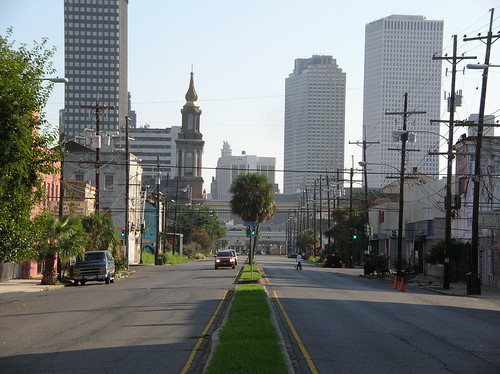
Oretha Castle Haley Blvd August 2008
Here comes the beautification crew.
The city began construction Wednesday on a $1.8 million project designed to make it easier and more inviting for people to walk and bike on Oretha Castle Haley Boulevard in Central City.
The project, funded by federal grants, is the latest in a series of "streetscape" beautification projects officials have unveiled since Mayor Mitch Landrieu took office in 2010.
The work will stretch along O.C. Haley from Calliope Street to St. Andrew Street.
Crews will remove the neutral ground from Felicity Street to Martin Luther King Jr. Boulevard, repair damaged sidewalks and install handicapped curb ramps at intersections. They also will add a bike lane and new crosswalks, plant new landscaping and repave the asphalt roadway, among other improvements, officials said.
That last paragraph offers more detail than did the mayor's press release yesterday. The only specific it offered was the bike lane. I started to ask for more information but the mayor's office just tweeted the same press release back at me.
Oh well. Anyway, one reason I wanted to ask about the bike lane is, although the city is quick to advertise the progress it has made in installing painted lanes in recent years, the so-called best practices have already moved beyond this style.
BOSTON (AP) — Bike lanes are evolving. Cities are increasingly changing them to make them safer in light of fatal crashes involving cyclists and cars.Basically, we've been doing it wrong and other cities are already finding ways to do it better. This OCH project might have been an opportunity for us to think about how to make a better bike lane. Instead we're just gonna keep congratulating ourselves.
From Boston to San Francisco and New York to Tokyo, traditional bike lanes running alongside vehicle traffic are being replaced in favor of “protected” lanes or “cycletracks,” where physical barriers like concrete curbs, planters or fences separate cyclists from vehicle traffic.
“For 50 years, we’ve just been putting down a stripe of white paint, and that was how you accommodated bikes on busy streets,” says Martha Roskowski, director of People for Bikes, a Boulder, Colorado-based advocacy group that’s calling for better designed bike lanes. “What we’ve learned is that simply doesn’t work for most.”
“Oretha Castle Haley Boulevard is one of our city’s great boulevards, with a rich and diverse history that is uniquely New Orleans,” Landrieu said. “Today, this corridor is seeing a resurgence, and our streetscape project will complement the major public and private investments that have already been made here and trigger even more development for Central City and beyond.”Also, notice the way Mitch can't help talking about the "public-private" nature of the corridor's
Federal Disaster Community Development Block Grant money will pay for the project, which was designed by GEC.This week marks ten years plus one since the flooding of New Orleans following Hurricane Katrina. And we're still benefiting from the CDBG-DR investment delivered as a result. On Tuesday the Governor informed President Obama that his staff would be requesting CDBG funding to help South Louisiana recover from this year's devastating floods. The size of this request will be critical. As long as we're running around making suppositions like this one by State Sen Francis Thompson, we might as well capitalize on them, right?
Sen. Thompson says he thinks that #laflood will end up being more expensive than Katrina or Rita. #lalege— Elizabeth Crisp (@elizabethcrisp) August 25, 2016
The more money we pull down from Washington now, the more streets we can "beautify" ten years from now. Who knows, by then, we might even know how to make a proper bike lane.
No comments:
Post a Comment